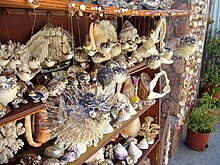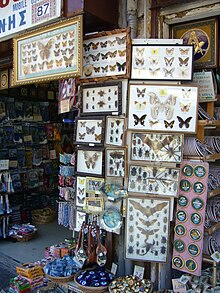
Back تجارة الحيوانات البرية Arabic Comerç d'animals salvatges Catalan Handel mit Wildtieren German Comercio de animales salvajes Spanish تجارت حیاتوحش Persian Trafic d'animaux French Perdagangan satwa liar ID Handel in exotische dieren Dutch Tráfico de animais Portuguese වනජීවී වෙළඳාම Singhalese
This article needs additional citations for verification. (February 2014) |


Wildlife trade refers to the products that are derived from non-domesticated animals or plants usually extracted from their natural environment or raised under controlled conditions. It can involve the trade of living or dead individuals, tissues such as skins, bones or meat, or other products. Legal wildlife trade is regulated by the United Nations' Convention on International Trade in Endangered Species of Wild Fauna and Flora (CITES), which currently has 184 member countries called Parties.[1] Illegal wildlife trade is widespread and constitutes one of the major illegal economic activities, comparable to the traffic of drugs and weapons.[2]
Wildlife trade is a serious conservation problem, has a negative effect on the viability of many wildlife populations and is one of the major threats to the survival of vertebrate species.[3] The illegal wildlife trade has been linked to the emergence and spread of new infectious diseases in humans, including emergent viruses.[4][5] Global initiative like the United Nations Sustainable Development Goal 15 have a target to end the illegal supply of wildlife.[6]
- ^ CITES 2013. Member countries. CITES Secretariat, Geneva.
- ^ Izzo, J. B. (2010). "PC Pets for a Price: Combating Online and Traditional Wildlife Crime Through International Harmonization and Authoritative Policies". William and Mary Environmental Law and Policy Journal. 34 (3).
- ^ Vié, J.-C.; Hilton-Taylor, C.; Stuart, S.N. (2009). Wildlife in a Changing World – An Analysis of the 2008 IUCN Red List of Threatened Species (PDF). Gland, Switzerland: IUCN. ISBN 978-2-8317-1063-1. Retrieved 2 May 2016.
- ^ Smith KM, Anthony SJ, Switzer WM, et al. (2012). "Zoonotic viruses associated with illegally imported wildlife products". PLOS ONE. 7 (1): e29505. Bibcode:2012PLoSO...729505S. doi:10.1371/journal.pone.0029505. PMC 3254615. PMID 22253731.
- ^ Smith, KF; Schloegel, LM; Rosen, GE (2012). "Wildlife Trade and the Spread of Disease". In A. Alonso Aguirre; Richard Ostfeld; Peter Daszak (eds.). New Directions in Conservation Medicine: Applied Cases of Ecological Health. Oxford University Press. pp. 151–163. ISBN 978-0-19-990905-6.
- ^ "Goal 15 targets". UNDP. Retrieved 2020-09-25.
© MMXXIII Rich X Search. We shall prevail. All rights reserved. Rich X Search